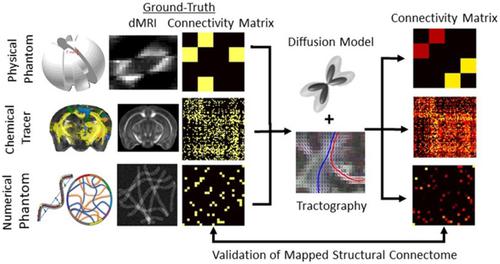当前位置:
X-MOL 学术
›
NMR Biomed.
›
论文详情
Our official English website, www.x-mol.net, welcomes your
feedback! (Note: you will need to create a separate account there.)
A critical review of connectome validation studies
NMR in Biomedicine ( IF 2.7 ) Pub Date : 2021-09-13 , DOI: 10.1002/nbm.4605 Tabinda Sarwar 1 , Kotagiri Ramamohanarao 2 , Andrew Zalesky 3, 4
NMR in Biomedicine ( IF 2.7 ) Pub Date : 2021-09-13 , DOI: 10.1002/nbm.4605 Tabinda Sarwar 1 , Kotagiri Ramamohanarao 2 , Andrew Zalesky 3, 4
Affiliation

|
Diffusion MRI tractography is the most widely used macroscale method for mapping connectomes in vivo. However, tractography is prone to various errors and biases, and thus tractography-derived connectomes require careful validation. Here, we critically review studies that have developed or utilized phantoms and tracer maps to validate tractography-derived connectomes, either quantitatively or qualitatively. We identify key factors impacting connectome reconstruction accuracy, including streamline seeding, propagation and filtering methods, and consider the strengths and limitations of state-of-the-art connectome phantoms and associated validation studies. These studies demonstrate the inherent limitations of current fiber orientation models and tractography algorithms and their impact on connectome reconstruction accuracy. Reconstructing connectomes with both high sensitivity and high specificity is challenging, given that some tractography methods can generate an abundance of spurious connections, while others can overlook genuine fiber bundles. We argue that streamline filtering can minimize spurious connections and potentially improve the biological plausibility of connectomes derived from tractography. We find that algorithmic choices such as the tractography seeding methodology, angular threshold, and streamline propagation method can substantially impact connectome reconstruction accuracy. Hence, careful application of tractography is necessary to reconstruct accurate connectomes. Improvements in diffusion MRI acquisition techniques will not necessarily overcome current tractography limitations without accompanying modeling and algorithmic advances.
中文翻译:

对连接组验证研究的批判性回顾
扩散 MRI 纤维束成像是在体内绘制连接组图的最广泛使用的宏观方法. 然而,纤维束成像容易出现各种错误和偏差,因此纤维束成像衍生的连接组需要仔细验证。在这里,我们批判性地回顾了已经开发或利用体模和示踪图来定量或定性地验证牵引成像衍生的连接组的研究。我们确定了影响连接组重建准确性的关键因素,包括简化播种、传播和过滤方法,并考虑最先进的连接组模型和相关验证研究的优势和局限性。这些研究证明了当前纤维取向模型和纤维束成像算法的固有局限性及其对连接组重建精度的影响。重建具有高灵敏度和高特异性的连接组具有挑战性,鉴于某些纤维束成像方法会产生大量虚假连接,而其他方法可能会忽略真正的纤维束。我们认为,流线过滤可以最大限度地减少虚假连接,并有可能提高来自纤维束成像的连接组的生物学合理性。我们发现,诸如纤维束播种方法、角度阈值和流线传播方法等算法选择可以显着影响连接组重建的准确性。因此,必须仔细应用纤维束成像来重建准确的连接组。如果没有伴随的建模和算法进步,扩散 MRI 采集技术的改进不一定会克服当前的纤维束成像限制。我们认为,流线过滤可以最大限度地减少虚假连接,并有可能提高来自纤维束成像的连接组的生物学合理性。我们发现,诸如纤维束播种方法、角度阈值和流线传播方法等算法选择可以显着影响连接组重建的准确性。因此,必须仔细应用纤维束成像来重建准确的连接组。如果没有伴随的建模和算法进步,扩散 MRI 采集技术的改进不一定会克服当前的纤维束成像限制。我们认为,流线过滤可以最大限度地减少虚假连接,并有可能提高来自纤维束成像的连接组的生物学合理性。我们发现,诸如纤维束播种方法、角度阈值和流线传播方法等算法选择可以显着影响连接组重建的准确性。因此,必须仔细应用纤维束成像来重建准确的连接组。如果没有伴随的建模和算法进步,扩散 MRI 采集技术的改进不一定会克服当前的纤维束成像限制。我们发现,诸如纤维束播种方法、角度阈值和流线传播方法等算法选择可以显着影响连接组重建的准确性。因此,必须仔细应用纤维束成像来重建准确的连接组。如果没有伴随的建模和算法进步,扩散 MRI 采集技术的改进不一定会克服当前的纤维束成像限制。我们发现,诸如纤维束播种方法、角度阈值和流线传播方法等算法选择可以显着影响连接组重建的准确性。因此,必须仔细应用纤维束成像来重建准确的连接组。如果没有伴随的建模和算法进步,扩散 MRI 采集技术的改进不一定会克服当前的纤维束成像限制。
更新日期:2021-11-17
中文翻译:

对连接组验证研究的批判性回顾
扩散 MRI 纤维束成像是在体内绘制连接组图的最广泛使用的宏观方法. 然而,纤维束成像容易出现各种错误和偏差,因此纤维束成像衍生的连接组需要仔细验证。在这里,我们批判性地回顾了已经开发或利用体模和示踪图来定量或定性地验证牵引成像衍生的连接组的研究。我们确定了影响连接组重建准确性的关键因素,包括简化播种、传播和过滤方法,并考虑最先进的连接组模型和相关验证研究的优势和局限性。这些研究证明了当前纤维取向模型和纤维束成像算法的固有局限性及其对连接组重建精度的影响。重建具有高灵敏度和高特异性的连接组具有挑战性,鉴于某些纤维束成像方法会产生大量虚假连接,而其他方法可能会忽略真正的纤维束。我们认为,流线过滤可以最大限度地减少虚假连接,并有可能提高来自纤维束成像的连接组的生物学合理性。我们发现,诸如纤维束播种方法、角度阈值和流线传播方法等算法选择可以显着影响连接组重建的准确性。因此,必须仔细应用纤维束成像来重建准确的连接组。如果没有伴随的建模和算法进步,扩散 MRI 采集技术的改进不一定会克服当前的纤维束成像限制。我们认为,流线过滤可以最大限度地减少虚假连接,并有可能提高来自纤维束成像的连接组的生物学合理性。我们发现,诸如纤维束播种方法、角度阈值和流线传播方法等算法选择可以显着影响连接组重建的准确性。因此,必须仔细应用纤维束成像来重建准确的连接组。如果没有伴随的建模和算法进步,扩散 MRI 采集技术的改进不一定会克服当前的纤维束成像限制。我们认为,流线过滤可以最大限度地减少虚假连接,并有可能提高来自纤维束成像的连接组的生物学合理性。我们发现,诸如纤维束播种方法、角度阈值和流线传播方法等算法选择可以显着影响连接组重建的准确性。因此,必须仔细应用纤维束成像来重建准确的连接组。如果没有伴随的建模和算法进步,扩散 MRI 采集技术的改进不一定会克服当前的纤维束成像限制。我们发现,诸如纤维束播种方法、角度阈值和流线传播方法等算法选择可以显着影响连接组重建的准确性。因此,必须仔细应用纤维束成像来重建准确的连接组。如果没有伴随的建模和算法进步,扩散 MRI 采集技术的改进不一定会克服当前的纤维束成像限制。我们发现,诸如纤维束播种方法、角度阈值和流线传播方法等算法选择可以显着影响连接组重建的准确性。因此,必须仔细应用纤维束成像来重建准确的连接组。如果没有伴随的建模和算法进步,扩散 MRI 采集技术的改进不一定会克服当前的纤维束成像限制。











































 京公网安备 11010802027423号
京公网安备 11010802027423号